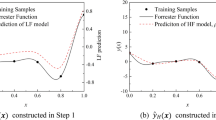Abstract
The determination of complex underlying relationships between system parameters from simulated and/or recorded data requires advanced interpolating functions, also known as surrogates. The development of surrogates for such complex relationships often requires the modeling of high dimensional and non-smooth functions using limited information. To this end, the hybrid surrogate modeling paradigm, where different surrogate models are combined, offers an effective solution. In this paper, we develop a new high fidelity surrogate modeling technique that we call the Adaptive Hybrid Functions (AHF). The AHF formulates a reliable Crowding Distance-Based Trust Region (CD-TR), and adaptively combines the favorable characteristics of different surrogate models. The weight of each contributing surrogate model is determined based on the local measure of accuracy for that surrogate model in the pertinent trust region. Such an approach is intended to exploit the advantages of each component surrogate. This approach seeks to simultaneously capture the global trend of the function as well as the local deviations. In this paper, the AHF combines four component surrogate models: (i) the Quadratic Response Surface Model (QRSM), (ii) the Radial Basis Functions (RBF), (iii) the Extended Radial Basis Functions (E-RBF), and (iv) the Kriging model. The AHF is applied to standard test problems and to a complex engineering design problem. Subsequent evaluations of the Root Mean Squared Error (RMSE) and the Maximum Absolute Error (MAE) illustrate the promising potential of this hybrid surrogate modeling approach.











Similar content being viewed by others
References
Acar E (2010) Various approaches for constructing an ensemble of metamodels using local measures. Struct Multidisc Optim 42(6):879–896
Acar E, Rais-Rohani M (2009) Ensemble of metamodels with optimized weight factors. Struct Multidisc Optim 37(3):279–294
Basudhar A, Missoum S (2008) Adaptive explicit decision functions for probabilistic design and optimization using support vector machines. Comput Struct 86(19–20):1904–1917
Bichon BJ, Eldred MS, Swiler LP, Mahadevan S, McFarland JM (2008) Efficient global reliability analysis for nonlinear implicit performance functions. AIAA J 46(10):2459–2468
Bichon BJ, Mahadevan S, Eldred MS (2009) Reliability-based design optimization using efficient global reliability analysis. In: 50th AIAA/ASME/ASCE/AHS/ASC structures, structural dynamics, and materials conference, Palm Springs, California
Bratley P, Fox B (1988) Algorithm 659: implementing Sobol’s quasirandom sequence generator. ACM Trans Math Softw 14(1):88–100
Cherrie JB, Beatson RK, Newsam GN (2002) Fast evaluation of radial basis functions: methods for generalized multiquadrics in r n. SIAM J Sci Comput 23(5):1549–1571
Chowdhury S, Messac A, Zhang J, Castillo L, Lebron J (2010) Optimizing the unrestricted placement of turbines of differing rotor diameters in a wind farm for maximum power generation. In: ASME 2010 international design engineering technical conferences (IDETC), Montreal, Canada
Chowdhury S, Zhang J, Messac A, Castillo L (2012) Unrestricted wind farm layout optimization (uwflo): investigating key factors influencing the maximum power generation. Renew Energy 38(1):16–30
Clarke S, Griebsch J, Simpson T (2005) Analysis of support vector regression for approximation of complex engineering analyses. J Mech Des 127(6):1077–1087
Cressie N (1993) Statistics for spatial data. Wiley, New York
Deb K (2001) Multi-objective optimization using evolutionary algorithms. Wiley, New York
Duda R, Hart P, Stork D (2000) Pattern classification, 2nd edn. Wiley-Interscience, New York
Forrester A, Keane A (2009) Recent advances in surrogate-based optimization. Prog Aerosp Sci 45(1–3):50–79
Forrester A, Sobester A, Keane A (2008) Engineering design via surrogate modelling: a practical guide. Wiley, New York
Giunta A, Watson L (1998) A comparison of approximation modeling techniques: polynomial versus interpolating models. Tech Rep AIAA-98-4758
Goel T, Haftka R, Shyy W, Queipo N (2007) Ensemble of surrogates. Struct Multidisc Optim 33(3):199–216
Hardy RL (1971) Multiquadric equations of topography and other irregular surfaces. J Geophys Res 76:1905–1915
Huang D, Allen TT, Notz WI, Zeng N (2006) Global optimization of stochastic black-box systems via sequential kriging meta-models. J Glob Optim 34(3):441–466
Hussain MF, Barton RR, Joshi SB (2002) Metamodeling: radial basis functions, versus polynomials. Eur J Oper Res 138(1):142–154
Jin R, Chen W, Simpson T (2001) Comparative studies of metamodelling techniques under multiple modelling criteria. Struct Multidisc Optim 23(1):1–13
Jones D, Schonlau M, Welch W (1998) Efficient global optimization of expensive black-box functions. J Glob Optim 13(4):455–492
Lophaven S, Nielsen H, Sondergaard J (2002) Dace—a matlab Kriging toolbox, version 2.0. Tech Rep Informatics and mathematical modelling report IMM-REP-2002-12, Technical University of Denmark
McKay M, Conover W, Beckman R (1979) A comparison of three methods for selecting values of input variables in the analysis of output from a computer code. Technometrics 21(2):239–245
Mullur A, Messac A (2005) Extended radial basis functions: more flexible and effective metamodeling. AIAA J 43(6):1306–1315
Mullur A, Messac A (2006) Metamodeling using extended radial basis functions: a comparative approach. Eng Comput 21(3):203–217
Myers R, Montgomery D (2002) Response surface methodology: process and product optimization using designed experiments, 2nd edn. Wiley-Interscience, New York
NDAWN (2010) The North Dakota Agricultural Weather Network. http://ndawn.ndsu.nodak.edu/
Queipo N, Haftka R, Shyy W, Goel T, Vaidyanathan R, Tucker P (2005) Surrogate-based analysis and optimization. Prog Aerosp Sci 41(1):1–28
Sakata S, Ashida F, Zako M (2003) Structural optimization using Kriging approximation. Comput Methods Appl Mech Eng 192(7–8):923–939
Sanchez E, Pintos S, Queipo N (2008) Toward an optimal ensemble of kernel-based approximations with engineering applications. Struct Multidisc Optim 36(3):247–261
Simpson T (1998) A concept exploration method for product family design. PhD thesis, Georgia Institute of Technology
Simpson T, Toropov V, Balabanov V, Viana F (2008) Design and analysis of computer experiments in multidisciplinary design optimization: a review of how far we have come—or not. In: 12th AIAA/ISSMO multidisciplinary analysis and optimization conference, Victoria, Canada
Sobol I (1976) Uniformly distributed sequences with an additional uniform property. USSR Comput Math Math Phys 16(5):236–242
Vapnik V (1995) The nature of statistical learning theory. Springer, New York
Viana F, Haftka R, Steffen V (2009) Multiple surrogates: how cross-validation errors can help us to obtain the best predictor. Struct Multidisc Optim 39(4):439–457
Viana FAC, Haftka RT, Watson LT (2010) Why not run the efficient global optimization algorithm with multiple surrogates? In: 51st AIAA/ASME/ASCE/AHS/ASC structures, structural dynamics, and materials conference, Orlando, Florida
Wang G, Shan S (2007) Review of metamodeling techniques in support of engineering design optimization. J Mech Des 129(4):370–380
Yegnanarayana B (2004) Artificial neural networks. PHI Learning Pvt Ltd
Zerpa L, Queipo N, Pintos S, Salager J (2005) An optimization methodology of alkalinesurfactantpolymer flooding processes using field scale numerical simulation and multiple surrogates. J Pet Sci Eng 47(3–4):197–208
Zhang J, Chowdhury S, Messac A, Castillo L (2010a) Economic evaluation of wind farms based on cost of energy optimization. In: 13th AIAA/ISSMO multidisciplinary analysis optimization conference, Fort Worth, Texas
Zhang J, Chowdhury S, Messac A, Castillo L, Lebron J (2010b) Response surface based cost model for onshore wind farms using extended radial basis functions. In: ASME 2010 international design engineering technical conferences (IDETC), Montreal, Canada
Zhang JQ, Messac A, Zhang J, Chowdhury S (2010c) Comparison of surrogate models used for adaptive optimal control of active thermoelectric windows. In: 13th AIAA/ISSMO multidisciplinary analysis optimization conference, Fort Worth, Texas
Zhou X, Ma Y, Li X (2011) Ensemble of surrogates with recursive arithmetic average. Struct Multidisc Optim. doi:10.1007/s00158-011-0655-6
Acknowledgement
Support from the National Science Foundation Awards CMMI-1100948, and CMMI-0946765 is gratefully acknowledged.
Author information
Authors and Affiliations
Corresponding author
Rights and permissions
About this article
Cite this article
Zhang, J., Chowdhury, S. & Messac, A. An adaptive hybrid surrogate model. Struct Multidisc Optim 46, 223–238 (2012). https://doi.org/10.1007/s00158-012-0764-x
Received:
Revised:
Accepted:
Published:
Issue Date:
DOI: https://doi.org/10.1007/s00158-012-0764-x




